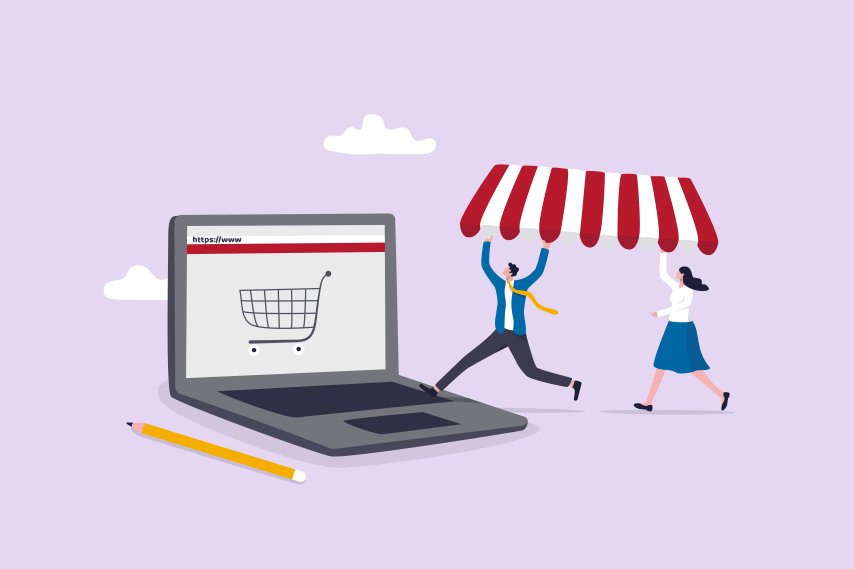How to successfully create a Shopify store: step by step to your own online store

Creating a Shopify store is the first step towards e-commerce success. In this blog article, we'll show you how to set up and launch your own Shopify store in no time. Whether you're a newbie or an experienced online entrepreneur, the steps are simple and clearly laid out to make it easy to get started.
The most important things at a glance
- Shopify provides a comprehensive platform for setting up an online store and offers everything you need for successful online sales, from design to technical support. Planning and researching goals, taxes and laws in advance is essential.
- Choosing a unique and memorable store name and registering the Shopify account correctly are crucial steps before designing the store experience. This includes an appealing visual identity as well as an intuitive navigation and page structure.
- Before launching the store, it is important to carefully present products with detailed information and quality media files, configure a seamless checkout process and implement an effective marketing and SEO strategy, as well as consider legal aspects and data protection regulations.
The first step towards your own online business
Shopify is more than just a platform for creating an online store. It's a comprehensive toolkit that gives you everything you need to sell successfully online. With Shopify you can:
- create attractive, target group-oriented and convincing websites without any prior technical knowledge
- realize classic online stores or websites
- access the necessary tools and support from verified Shopify partners
But before you get started, it's important to understand your own goals and find out about taxes and laws. Do you want to offer an extensive product portfolio or start with a few selected products? The choice is entirely up to you. Solid planning is the first step to your successful online business.
Choosing the perfect store name
A good name can make the difference between success and failure. Your store name should therefore be easy to remember and pronounce, stand out from the competition and reflect the type of products you sell.
However, before you finally decide on a name, you should check whether it is already taken. To do this, you can use databases such as the business register or consult a specialized lawyer to check availability. After all, a unique and memorable store name is the key to success!
Registering your Shopify account
Once you've chosen the perfect store name, it's time to create your Shopify account. The registration process with Shopify is simple and only requires basic information such as your email address, a password and of course the store name.
Please note that the store name you choose when registering is the default URL for your store and cannot be changed later. However, you have the option of adding a user-defined domain.
The entire registration process only takes a few minutes and is therefore another step on the way to your own online store as an online retailer. In our step-by-step guide, you can find out how easy it is to set up your store.
Design your store experience
Once you have successfully set up your account, it's time to design your store experience. Shopify offers you numerous options for customizing your store, from typography and layout to animations.
But even subtleties like adding a favicon to represent your brand in web browser tabs can make all the difference. Whether you already have concrete ideas or are still looking for inspiration, Shopify offers all the tools you need to design your store experience.
Define visual branding
Consistent visual branding is crucial to the success of your store. Shopify offers a variety of ways to do this, from choosing a color scheme to setting fonts and defining a favicon.
The customization of customer accounts and the design of the login page also contribute to the visual appearance of the store. Consistent and appealing visual branding gives your store a professional look and can boost customer confidence.
Navigation and page structure
The navigation and structure of your pages are just as important as the visual design. Well-structured navigation makes it easier for customers to find their way around your website and find relevant information or products quickly.
In addition to the product presentation, information pages such as 'About us' and 'Contact' are also important. They help to create trust with customers and provide necessary information. An intuitive layout and a clear structure of your site are therefore essential.
Add and present products
Now it's getting exciting: it's time to add and present your products! Shopify makes it easy for you to add new products and provide them with appealing product descriptions and high-quality media files. To add your store, simply follow the instructions on the platform.
It is also possible to duplicate product entries to save time. You can adjust certain details before creating the duplicate. Convincing product presentations are a key element for the success of your online store.
Enter product information
Meaningful product information is crucial for your customers' purchasing decisions. You should therefore pay attention to details such as ingredients, taste or combination options with other items when creating your product entries.
Tags can help you to improve the searchability of your products within your Shopify store. Remember: the more information you provide to your customers, the easier it will be for them to make a purchase decision. Use your expertise to choose the right tags.
Upload media files
High-quality media files are essential to present your products in an appealing way. Shopify allows you to upload photos, GIFs, videos or even 3D models for each product.
Additional photos from different angles or detailed shots can help the customer make an informed purchase decision. Make sure your product images are of high quality and represent your product realistically.
Configure payment processing and checkout
Once you've added your products and presented them attractively, it's time to configure the payment processing and checkout. Shopify makes it easy for you to set up different payment methods and personalize the checkout process.
It's important that you carefully plan all aspects of the checkout process to provide your customers with a smooth and enjoyable checkout experience. Whether you choose Shopify Payments or another payment method, make sure the process is simple and straightforward for your customers.
Set up payment methods
Choosing the right payment methods can make a big difference for your customers. Shopify gives you the option to set up different payment methods to provide your customers with a convenient checkout experience.
Whether credit and debit cards, PayPal or other online payment services - the choice is yours. Make sure you offer payment methods that your target group prefers and trusts.
Personalize the checkout process
A personalized checkout process can provide your customers with a pleasant shopping experience. Shopify allows you to customize the look of the checkout and personalize the process by integrating terms and conditions and cancellation policies.
In addition, Shop Pay allows you to speed up the checkout process by storing your customers' purchase information. An intuitive and personalized checkout process can help increase your Shopify store's sales.
Define shipping options
Choosing the right shipping options is another important aspect of setting up your Shopify store. You can choose between different shipping rates, including free shipping, flat rate shipping or calculated shipping costs.
With Shopify, you can configure shipping rates for specific products or locations and even set up special discounts on shipping rates to customize costs. Remember that your shipping options can have a big impact on customer satisfaction.
Marketing and SEO for your Shopify store
Once your store is set up and ready to launch, it's time to think about marketing and SEO for the store. Shopify offers you a variety of tools and strategies to successfully promote your store.
From Google Analytics to social media and email marketing, there are many ways to increase your store's reach and reach more customers. Make sure you have a comprehensive marketing and SEO strategy in place to maximize the success of your Shopify store.
Use Google and social media
Integrating Google Analytics and social media platforms can help you increase the reach of your Shopify store and reach more customers. Whether you want to collect data about store visitors and use it for retargeting and targeted marketing, or increase your reach on platforms like Instagram, Shopify provides you with the tools and strategies you need. Make sure you take advantage of these opportunities to realize the full potential of your Shopify store.
Set up email marketing
Email marketing is another effective strategy for promoting your Shopify store. Shopify allows you to use sign-up forms and lead magnets to build an email list and send personalized emails to your customers.
With platforms like Klaviyo or Mailchimp, you can design your email campaigns, run A/B tests and analyze the performance of your campaigns. A well-thought-out email marketing strategy can help to increase customer loyalty and boost your sales.
Legal aspects and data protection
When operating an online store, you need to consider various legal aspects and data protection regulations. Shopify offers you extensive tools and ongoing adjustments to court rulings to help you operate your online store in a legally compliant manner.
The integration of legal information during the checkout is also integrated into Shopify. Nevertheless, it is recommended that you consult with legal experts to ensure the full legal compliance of your Shopify store.
Ready to go: The path to launching your Shopify store
Now you're ready to launch your Shopify store! However, before you go live, you should run some test orders in steps to make sure the checkout process works smoothly.
After the test orders, you can remove the password protection and make your store accessible to your customers. In addition, we recommend integrating a chat widget to facilitate direct communication with your customers and improve customer service after the launch. Javascript code can be helpful here.
Conclusion
You've now gone through a complete guide to creating your own Shopify store. Now you're ready to launch your own successful Shopify store. If you still have any questions, we'll be happy to help you with every step of your online store. Because as a Shopify agency, we know what's important.
Was ist dein Projekt? Wenn du uns darüber erzählen möchtest, rufen wir dich zurück!

Hello, my name is Meike. I take care of the EXWE back office and am responsible for our social media channels. All of our articles are meant to make your life easier and help you make decisions. Nevertheless, it can happen that something remains unclear, so: If you have questions about this article you can easily reach me at +49 231 93149827.
xtCommerce - Insert remarks in confirmation mail
We make the big Shopware and Salesforce comparison so that you can find out which store system is best suited to your company.
Here are ten good PayPal alternatives for your online store: Easy-to-integrate payment methods for fast payment processing for your customers.





